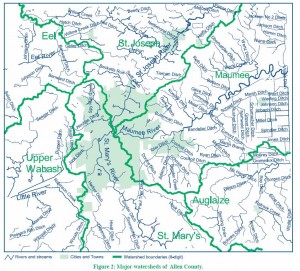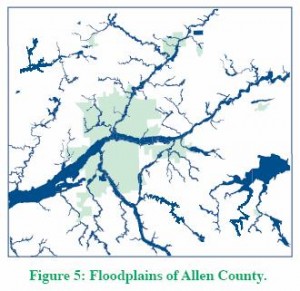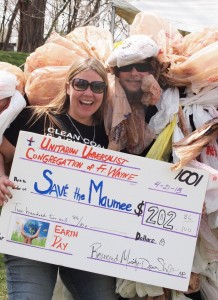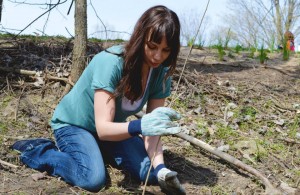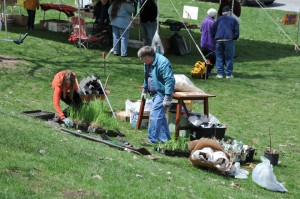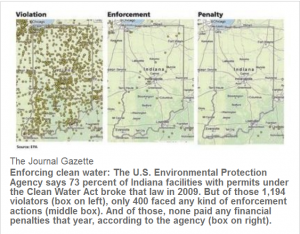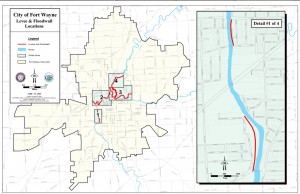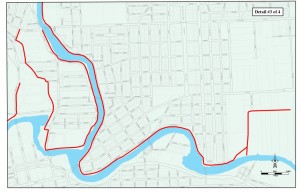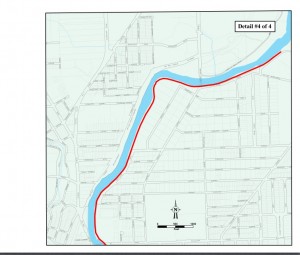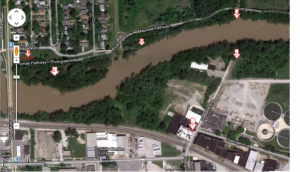Dr. Jordan Marshall – IPFW Environmental Conservation Class
Monday October 15, 2012 1:30– 2:30pm
Location: St. Joseph and St. Marys converge into the headwaters of the Maumee River – .7 miles downstream easterly
Hosey Dam (at N. Anthony Bridge) North bank of the Maumee River; (floodway/spillway- direct middle) sand, loam, clay, river sediment
NUMBER OF VOLUNTEER PARTICIPANTS – 24
Save Maumee Programing
Project with IPFW Environmental Conservation Class
In-kind student volunteers completed restoration project
CLICK HERE FOR PICTURES
In the floodway we planted 4 Pin Oak, 2 Mulberry, 2 River Birch, and one Hornbeam and 30 Oak Acorns into the stretch of river where Save Maumee conducts the majority of conservation projects. As a group today, we also planted native DNR approved seeds; Big Blue Stem, Indian Grass, Switchgrass, New England Aster, Grass Leaved Goldenrod, Prairie Dock, Virginia Mountain Mint, Ironweed, Purple Coneflower, Monarda, and Black Eyed Susan and a few unidentified sedges. We installed the seed blend under 19 feet of coconut mesh, called erosion-control-mats or GeoJute. GeoJute is made from coconut fiber that will completely disintegrate in approximately 5 years. The coconut mesh is to hold down new life as the water raises and flows over the floodway.
Dr. Marshall brought it to my attention that several of the species I had mentioned may not do well under the tree canopy and prefer upland areas. SO TRUE! Different plants prefer different conditions. The top of that seed bag, I had harvested myself, had a blend of seed. With the experiment I have started in this area, I have found that not-ideal conditions still yield life! It just seems to stunt their growth, slowing their full potential for abundance. For example, the Prairie Dock should be “full sun”, but they still were prolific this year! These Prairie Dock were located on the high water mark, yet tree canopy covered. Black Eyed Susan has been suggested by our consultant, Eric Ummel, from Earth Source/Heartland Restoration. Black Eyed Susan has been extremely successful as shade tolerant in our efforts.
According to William Grant, retired Lagrange County Health Department Administrator, whom I personally interviewed in 2007.
“Wet Mesic Prairie Plants” are the suggested foliage for this area. “Wet Mesic Prairie Plants are a blend of plants that reduce nutrients and nitrates…ya know…these plants drink the stuff from leaking septic tanks, or dirty ditches.”
Dr. Marshall and I could split hairs, because many of these (above listed) plants are lowland grasses that like it moist and prefer soils primarily loam or silt. But I am still agreeing with Dr. Marshall, and appreciate his critique! YES, some are not “suitable” for this area.
Remember: Not all the plants will grow specifically where we dropped them. When the river rises, many will become dislodged and find different conditions downstream to germinate. Planting seed does not happen in a vacuum, it is static.
Lesson Learned for Myself: When I asked Dr. Marshall about his thoughts on listening to me speak on two different occasions recently: 1) IPFW Anthropology Dept. Lunch-In 2) Environmental Conservation Class. He gave me some great feedback that I needed to hear. We spoke of my reference to removing NATIVE wild grape vines. The good Dr. said, “this is only a snapshot of the biology of this area…it is part of the process that nature is creating. You should think seriously about the promotion of removing natives…where did you hear that?” So I wanted to clarify my thoughts on wild grape vine.
My erosion control projects started in 2005 and my research on our local rivers began in 2001. I think I misspoke, or was not clear, about Vitis riparia. This particular grape vine is prolific on my specific experimental floodway area on the north shore. I have selectively chosen ones that are choking-out other trees and working to achieve and promote diversity of other species through selective removal of V. riparia.
Other State and County Park representatives discuss how they have invasive like Callery flowering Pear tree, Garlic Mustard, or Polk (Phytolacca Americana is native to southeastern U.S.) Our riverbank does not have an over abundance of these because we remove them by hand, on sight. We do not promote removing riverbank plants or using chemicals, of any kind, 300ft from the open water source.
Save Maumee is suggesting that every Japanese Honeysuckle (non-natives are hollow in the middle) you see should be removed. The Japanese Honeysuckle has been shown to give local bird populations’ problems. Non-native berries do not provide the nutrients and minerals needed. Birds will therefore spend more time foraging for more food because they are lacking nutrition. This means they are not spending their precious time seeking a mate, nesting, nor tending to young.
These days many of the protected lands are managed. They have a conservation target that is created through a management plan. Many times the managed lands remove natives, like Cattails, because they smother other natives and discourage diversity around wet, stagnant water. This too is important to note! Thank you Dr. Marshall! This brings up the point that my management plan has been in my head and I need to create one for my Lake Erie Waterkeeper, Save Maumee Steering Committee.
My conservation target from my head:
GOAL: SWIMMABLE, FISHABLE, DRINKABLE WATER
*raise awareness
*plant diverse native species: slow erosion by slowing flood water as it violently runs over the floodway
to water takes a longer amount of time to naturally filtrate into the ground
*create this biodiversity through removing threats to the conservation target (i.e. removing invasives or overgrowth.
I will quote SaveMaumee.Org Website:
Siltation/erosion/sedimentation is the #1 pollutant in our watershed. The grasses will help to settle out suspended sediment in the water to help hold down the soil that could be washed away because there is nothing to hold down the barren soil when the water comes rushing down during a rain event.
Grasses filtrate sediment by holding water for a longer period of time so the sediment settles to the bottom instead of traveling downstream.
Removal of nutrients from the water before it passes downstream.
Plants produce enzymes which will absorb and “eat” bacteria
Natural removal of chemical pollutants like fertilizers and waste materials removes nitrogen, phosphorous and toxins from surface water.
Creating more shade will help to create Dissolved Oxygen that is needed in the water for fish and other wildlife to “breathe.”
Floods problems can be alleviated – grassy knolls and trees can capture, store and slowly release water over a longer period of time
Protect shorelines through reduction of destructive energy from fast moving/ rising water
Alleviate pools of standing, stagnant water so West Nile will not have the opportunity to be passed on in the mosquito or human population
Water quality, stormwater drainage and sewage issues recognize no political boundaries and need regional coordination.” (Plan-It-Allen, 2007)
The Upper – Maumee River Crosses 2 State Boundaries 4 County Boundaries Numerous Municipalities
Most people who live in cities downstream of Fort Wayne, use The Maumee River as their drinking water source. Other drinking water sources would include wells.
Dear Dr. Marshall, I respect and took into consideration all of your suggestions, thank you. Bringing students back into the field, instead of behind pencils, 3 miles away, is invaluable! THANK YOU TOO STUDENTS! ALL our work to this point has been through the kindness of volunteers. Please continue to keep an eye on us. We would love to have you at one of our meetings. We would look forward to many of your perspectives! Save Maumee Meetings are OPEN TO THE PUBLIC every 1st Monday of every month at Hall’s Gas House from 7-8:30pm. Please feel free to comment on anything, because I truly value your opinion and your students’ opinions!
Today, October 28, 2012 – We are working to find out more about the removal of our plantings via City of Fort Wayne, Board of Public Works (BPW)from orders passed down to the Army Corps of Engineers (ACE).
On Wednesday, October 24 we witnessed all foliage cut and any tree under three-inches in diameter being removed, in our conservation target area. We are now seeking the correspondence between the ACE and BPW regarding this sensitive situation. I will keep you informed. Makes me think now the grape vines were more important than I thought!
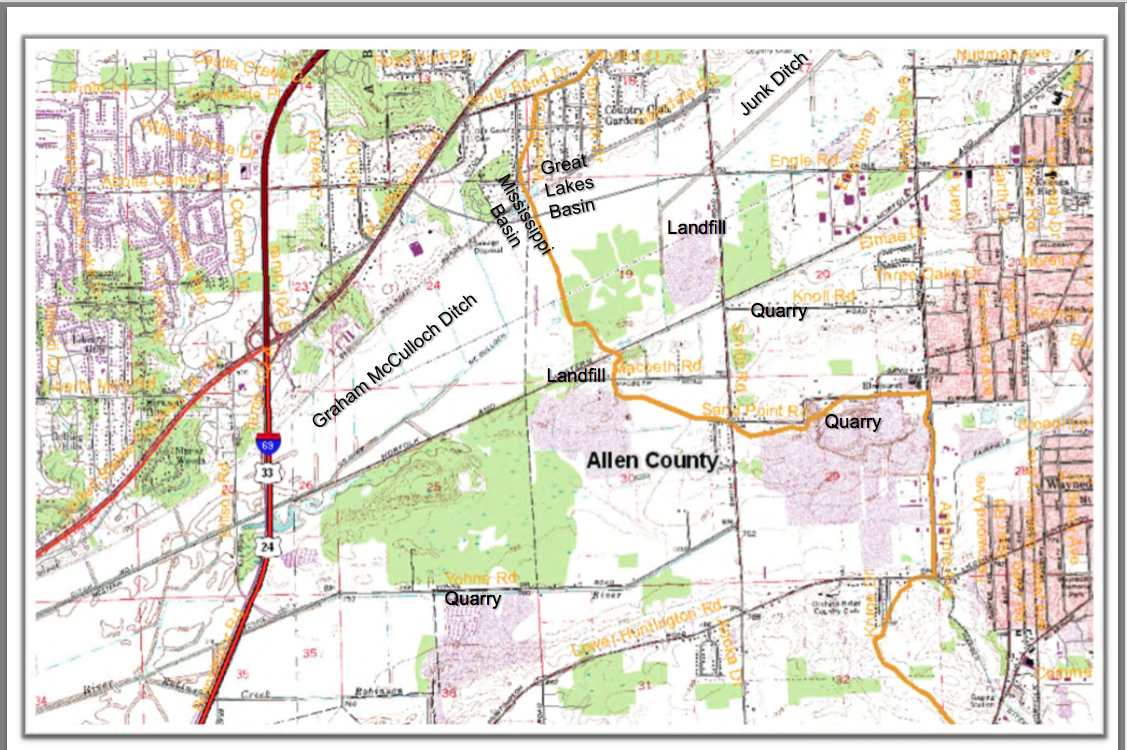 http://www.asiancarp.us/documents/Wabash-Maumee-Field-Report_Final_small.pdf
http://www.asiancarp.us/documents/Wabash-Maumee-Field-Report_Final_small.pdf
